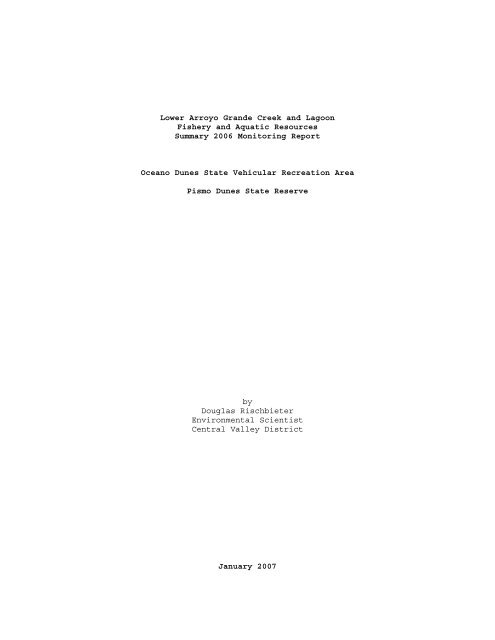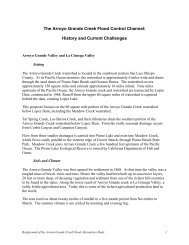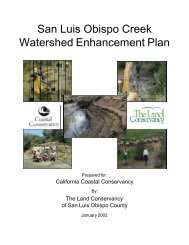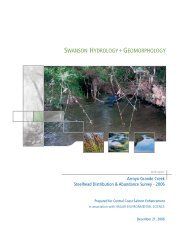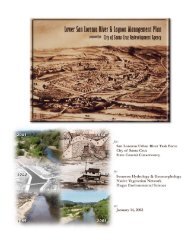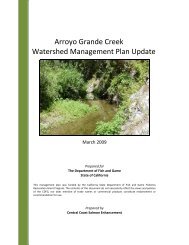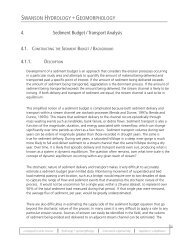Lower Arroyo Grande Creek and Lagoon Fishery and Aquatic ...
Lower Arroyo Grande Creek and Lagoon Fishery and Aquatic ...
Lower Arroyo Grande Creek and Lagoon Fishery and Aquatic ...
You also want an ePaper? Increase the reach of your titles
YUMPU automatically turns print PDFs into web optimized ePapers that Google loves.
<strong>Lower</strong> <strong>Arroyo</strong> <strong>Gr<strong>and</strong>e</strong> <strong>Creek</strong> <strong>and</strong> <strong>Lagoon</strong><strong>Fishery</strong> <strong>and</strong> <strong>Aquatic</strong> ResourcesSummary 2006 Monitoring ReportOceano Dunes State Vehicular Recreation AreaPismo Dunes State ReservebyDouglas RischbieterEnvironmental ScientistCentral Valley DistrictJanuary 2007
ABSTRACTThe lowest half-mile of <strong>Arroyo</strong> <strong>Gr<strong>and</strong>e</strong> <strong>Creek</strong>, including a periodically-closed euryhaline lagoon,is within or adjacent to Oceano Dunes State Vehicular Recreation Area (SVRA) <strong>and</strong> PismoDunes State Reserve (San Luis Obispo County, California). Qualitative sampling of the fisheryin this area was conducted four times throughout 2006, <strong>and</strong> this report is intended to summarizethe results of this activity. Purposes of sampling included gathering information about variousspecies' use of the habitats within the State Park, evaluating whether any Park activities may beimpacting the fishery <strong>and</strong> aquatic habitat, <strong>and</strong> documenting the impacts of habitat disturbancecaused by upstream water management activities. We used a generally-consistent regime ofelectrofishing, seining, dipnetting, <strong>and</strong> direct observation during each survey episode, whichfollowed methods <strong>and</strong> patterns established during similar activity in 2004 <strong>and</strong> 2005. A total of12 fish species were collected during the 2006 sampling. Of continued noteworthiness in 2006was the apparent tenuous presence in the lagoon of tidewater goby, a federally-listed Endangeredspecies. A single juvenile/post-larval goby was collected, the first indication of natural gobyreproduction at this location. Also noteworthy among the native fish collected were steelhead, afederally-listed Threatened species, usually present in the study reach in low numbers butdemonstrating a significant (relatively abundant) downstream migration during February highflows. Despite predictably low summer inflow to the lagoon, flow through the freshwater reachof <strong>Arroyo</strong> <strong>Gr<strong>and</strong>e</strong> <strong>Creek</strong> was reportedly sustained without interruption during 2006.INTRODUCTION<strong>Arroyo</strong> <strong>Gr<strong>and</strong>e</strong> <strong>Creek</strong> arises from the mountains of San Luis Obispo County <strong>and</strong> flows to thePacific Ocean. Within the watershed is one major reservoir, Lopez Lake storing up to 52,000acre-feet, that is situated about 15 miles upstream from the ocean. Within the last few miles tothe ocean, a low-gradient reach of stream flows through an alluvial agricultural valley <strong>and</strong> thenforms a lagoon behind the beach. The lagoon is closed by a s<strong>and</strong>bar in some summers, butotherwise flows over the beach to the sea. The terminal half-mile of <strong>Arroyo</strong> <strong>Gr<strong>and</strong>e</strong> <strong>Creek</strong>,including the aforementioned lagoon, are part of Oceano Dunes SVRA <strong>and</strong> Pismo SB DunePreserve. Adjacent to this reach of stream are a municipal airport <strong>and</strong> a wastewater treatmentplant. Most of the lower reach of the creek is confined by parallel levees <strong>and</strong> some riparianvegetation is periodically removed for flood control purposes. Relatively extensive vegetationremoval occurred in <strong>and</strong> adjacent to the upper half of the study area in the fall of 2005 <strong>and</strong> 2006.Study Area<strong>Arroyo</strong> <strong>Gr<strong>and</strong>e</strong> <strong>Creek</strong> in <strong>and</strong> adjacent to Oceano Dunes SVRA <strong>and</strong> Pismo SB Dune Preservetypically consists of three distinct aquatic habitats: a few hundred feet to yards of lowcomplexity,relatively shallow (maximum depth
uns, <strong>and</strong> glides. This upper reach is usually characterized by dense riparian vegetation on <strong>and</strong>overhanging the banks, <strong>and</strong> predominantly small-gravel substrate with sparse distribution oflarge woody debris fragments. The north end of the lagoon <strong>and</strong> both sides of the upstream reachare confined by levees.Figure 1 shows the lower half-mile of <strong>Arroyo</strong> <strong>Gr<strong>and</strong>e</strong> <strong>Creek</strong> <strong>and</strong> the relative locations of thehabitats described above. "Guiton Crossing" is the approximate upstream limit of State Parkownership, though electrofishing/sampling was conducted a few hundred feet upstream from thispoint on some occasions.Streamflow was cursorily estimated to be between about 0.5 <strong>and</strong> 7 cfs in the lotic areas during allsurvey periods. Water quality of lagoon inflow appeared good; water quality within the lagoonseemed good on all 2006 survey dates, even during the one instance of sampling during theperiod of lagoon mouth closure. High tides were observed washing seawater into the lagoon onseveral occasions. Periodic disturbances to these habitats during the survey period also includedshort-duration floods, beaver activity in <strong>and</strong> upstream from the lagoon, <strong>and</strong> autumn removal ofsome riparian vegetation for flood control maintenance purposes. The depth of the lagoon <strong>and</strong>its extent upstream varied notably, sometimes more than two feet, depending on the dynamics ofs<strong>and</strong>bar formation, inflow, outflow, tidal wash, <strong>and</strong> because of the location of a beaver dam inthe middle of the lagoon.Purpose <strong>and</strong> ScopeThis study was conducted for two primary purposes: 1) to continue the evaluation, commencedin 2003 through 2005 (Rischbieter 2004, 2006) of the composition <strong>and</strong> significance of the fisheryin <strong>Arroyo</strong> <strong>Gr<strong>and</strong>e</strong> <strong>Creek</strong> associated with State Park habitat; <strong>and</strong> 2) to gage the impact (if any) ofSVRA vehicle traffic on these aquatic resources, especially in the beach area where vehiclestraverse the wetted stream. Towards these goals, aquatic sampling was generally limited to thePark reach of <strong>Arroyo</strong> <strong>Gr<strong>and</strong>e</strong> <strong>Creek</strong>. Most information sought was qualitative. Quantitativeevaluation was limited to routine estimation of the relative abundance of species collected.MONITORING PROCEDURESWe typically used dipnets, beach seine, direct observation, <strong>and</strong> electrofishing to observe, collect,<strong>and</strong> identify fish in each of the three habitat zones described above. Each of these methods hadsome shortcomings in various areas from time to time, but generally a similar degree <strong>and</strong> type ofeffort was expended on each survey date. More detailed description of activities pursued duringeach of the seven surveys can be found within the summary reports prepared for each individualfish-sampling survey (Rischbieter, various dates). However, the following summary describestypical procedures conducted over the study period.The back-beach reach, lagoon-tail outlet area, <strong>and</strong> west end of the lagoon were usually subject to5-10 seine hauls using a 4' x 50' beach seine with 3/16" mesh. The seine was typically swept inan arc, with a set pivot-point on shore, <strong>and</strong> closed <strong>and</strong> dragged ashore. After each haul the seinewas checked for organisms <strong>and</strong>, if any were present, they were removed <strong>and</strong> identified <strong>and</strong>released.
FIGURE 1. Relative locations of zones of Study Area, lower <strong>Arroyo</strong> <strong>Gr<strong>and</strong>e</strong> <strong>Creek</strong> <strong>and</strong> <strong>Lagoon</strong>, San Luis Obispo County.1 - Surf-line Outlet Reach; 2 - Back-beach Reach; 3 - <strong>Lagoon</strong>-tail Outlet Area; 4 - <strong>Lagoon</strong> Pool; 5 - Upstream of <strong>Lagoon</strong> Head;6 - South Arm of <strong>Lagoon</strong> (transient in 2006, not present on any 2006 sampling dates) D1 - 2005-2006 Beaver Dam; S - Normal Surf Zone
Electrofishing was also conducted above the head of the lagoon. Effort was usually continuousfrom a relatively easy access point about 1,000 feet downstream of Guiton Crossing upstream toGuiton Crossing <strong>and</strong> occasionally 100-500 feet beyond. The electrofisher was accompanied bytwo netters, using dipnets, who netted immobilized fish <strong>and</strong> placed noteworthy or representativespecimens into a bucket for recovery, identification, <strong>and</strong> release. Roughly 1,000 seconds ofelectrofishing current was usually applied throughout this reach; settings were routinely 60 Hertzat 100-200 Volts DC.RESULTSThirteen species of fish were collected over the four survey dates. Species collected, relativelocations of collection for each species, general relative maturity of each species collected, <strong>and</strong>survey dates are summarized in Table 1. Virtually all fish collected were returned alive to theapproximate location of capture. Exceptions to the preceding statement include: 1) the basscaptured (February); 2) about 5 larval suckers taken for identification in June; 3) a juvenilegoby that succumbed to h<strong>and</strong>ling stress in September <strong>and</strong> could not be successfully released; <strong>and</strong>4) the dead bullhead found in December.No reptiles, only one amphibian (bullfrog tadpole, December), <strong>and</strong> seemingly few aquaticinvertebrates were observed during any of the surveys, but the lagoon <strong>and</strong> creek supportsubstantial numbers of migratory waterfowl. Wading shorebirds, both predators <strong>and</strong> scavengers,were frequently observed both resting <strong>and</strong> stalking in the lagoon, in back-beach pools, <strong>and</strong> in thesurf zone outlet reach.Beaver activity appeared to affect fish habitat. Though no beavers were seen, the dam in themiddle of the lagoon (originally constructed in 2005) produced two different lagoon water levelssimultaneously (the head of the lagoon was often about 18" higher than the lower half). Thisdam probably varied in height, consequently backing water further upstream <strong>and</strong> reducing theremaining reach suitable for electrofishing), especially by December. Several deeply-recessedbankside holes, presumed to be lodge entrances, provided habitat for a notable concentration ofnative fish.
TABLE 1. Fish of lower <strong>Arroyo</strong> <strong>Gr<strong>and</strong>e</strong> <strong>Creek</strong> <strong>and</strong> <strong>Lagoon</strong>: species collected, status, collection dates, approximate collection locations, <strong>and</strong> life history stagesobserved.SPECIESFEB 27, *JUN 6, SEP 19,STATUS 2006 2006 2006California roachLavinia symmetricusn O5,o5 A5,a5 A5,a5 u5speckled daceRhinichthys osculusN U5 -- -- --Sacramento suckerCatostomus occidentalis n O5,o5 O5,a2 A5,a5 O5,o5steelheadOncorhynchus mykissN a5,u2 o5 u5 u2mosquitofishGambusia affinisI -- -- u2 --threespine sticklebackGasterosteus aculeatus N O2,3,5; u2 Aa2,Aa5 Aa2,Aa5 U2,o2,u5black bullheadAmeiuras melasI -- -- -- u4largemouth bassMicropterus salmoidesI -- a2 u2 --prickly sculpinCottus asperN O5 A5,a5 O5,o5 O5,o5staghorn sculpinLeptocottus armatusN aA2,Aa3 u1,Oo2 A2,a2 o2tidewater gobyEucyclogobius newberryi N -- U2* u2 --starry flounderPlatyichthys stellatusN Uu2,Oo3 o2 U2 O2,o2DEC 20,2006 COMMENTSA 132mm (TL) specimen, captured in June, was thelargest of this species ever observed here.Only one individual, 50mm TL, seen in 2006(February).More captured (22) in 2006 than any previous (2003-2005) DPR survey period.First known AG <strong>Creek</strong> occurrence of this species;found recently-dead in lagoon.A 181mm (TL) specimen, captured in June, was thelargest of this species ever observed here.One individual found on each of 2 dates: June effortlimited; in September, 1st juvenile ever observed here"Adult" flounder probably sub-adult, but significantlylarger than young-of-year (ca. 120-155+ mm)KEY Status: N = Native to watershed; n = Native to California, but likely introduced to watershed; I = Introduced to CaliforniaZones Where Found (Figure 1): 1 - Surf-line Outlet Reach; 2 - Back-beach Reach; 3 - <strong>Lagoon</strong>-tail Outlet Area; 4 - <strong>Lagoon</strong> Pool (limited effort);5 - Upstream of <strong>Lagoon</strong> Head; 6 - South Arm of <strong>Lagoon</strong> (only present in March <strong>and</strong> December).* - Sampling limited because of Permitting delay; June collection of goby was unexpected.Abundance (UPPER CASE = Adults; lower case = Young-of-Year): A/a - Abundant or Common; O/o - Occasionally Collected; U/u - Infrequently Collected
DISCUSSIONThe 2006 surveys of <strong>Arroyo</strong> <strong>Gr<strong>and</strong>e</strong> <strong>Creek</strong> are noteworthy for several reasons. Thoughtidewater goby were rarely captured here, 2006 bore the first evidence of goby reproductionsince site colonization was documented early in 2005. High flow events appeared to beassociated with the downstream migration of numerous juvenile steelhead; the 13 individualscaptured (plus others eluding capture) in February were more than the cumulative total capturedduring the four surveys of the previous year. Exceptionally-large individual prickly sculpin <strong>and</strong>California roach were captured. The first occurrence of black bullhead here was recorded.Additional information <strong>and</strong> discussion related to each of the four surveys can be found within thesummary reports prepared for each individual fish sampling survey (Rischbieter, various dates).One species observed in 2005 (Rischbieter 2006), topsmelt, was not collected in 2006. Nativespeckled dace did not occur in 2005, but were collected in 2004. The possibility of blackbullhead was predicted (Rischbieter 2004), since they occur upstream in Lopez Lake, but the2006 collection here (of the first individual ever recorded in the Park) likely succumbed tobrackish- or salt-water conditions in the lagoon. Little conclusion can be drawn from thesespecies' observed status, as speckled dace have previously been present only in low numbers, <strong>and</strong>topsmelt are usually marine <strong>and</strong> occur only transitorily at this location. Overall, the difficulty ofsampling within the heart of the lagoon itself probably results in an understatement of thediversity <strong>and</strong> abundance of species in lower <strong>Arroyo</strong> <strong>Gr<strong>and</strong>e</strong> <strong>Creek</strong>.One purpose of this monitoring was to gain insight as to whether high traffic volume in theSVRA (including vehicles fording the seasonal lagoon outlet) might be affecting fish or theirhabitat. Regular closure of all or most of the back-beach reach to vehicle entry appears capableof avoiding or minimizing impacts. Vigilant maintenance of posted closure signs seemedeffective at almost eliminating public encroachment into sensitive closed lagoon areas, based onobservation on these survey dates of few if any straying tire tracks. In general however, fishtypically do not use the surf-line outlet reach, where vehicles most frequently <strong>and</strong> efficiently fordthe stream. Furthermore, the quality of habitat in this lowest reach (s<strong>and</strong> banks, s<strong>and</strong>y channel)does not appear to be significantly altered by vehicle traffic, owing largely to the naturallytransitory <strong>and</strong> dynamic nature of s<strong>and</strong>y features near the surf line <strong>and</strong> through the beach.RecommendationsRecommendations made earlier warrant repeating. Continued periodic fishery monitoring in thisarea will provide additional useful information for resource managers. Additional or continuedsampling may serve to identify the periodic presence of the aforementioned species in the future.The effect of freshets, late-summer drought, <strong>and</strong> other cyclic hydrologic conditions may bededuced in the future through continued monitoring. A similar frequency of surveying <strong>and</strong>monitoring (3-4 times throughout the year) is proposed to continue in 2007. The exact timing of2007 surveys should be scheduled dependent upon the timing of significant hydrologic eventssuch as following periods of flood, lagoon closing/opening, <strong>and</strong> any extended periods of low orno flow.
Future study objectives should continue to include attempts to sample <strong>and</strong> observe fish thatperiodically may reside in the area subject to regular vehicle traffic. Practically, this shouldusually be limited to the surf-line outlet reach; however, the back-beach reach of the creek isdynamic <strong>and</strong> occasionally is outside the vehicle closure zone. Even in the absence of futureevidence of direct or indirect impacts attributable to vehicle traffic upon fish of any species, theclosure zone should generally be aligned so as to include as much length <strong>and</strong> area of activestreambed as reasonably possible, to the degree practicable <strong>and</strong> consistent with necessary Parkoperations.The one goby (juvenile) collected in September remains in possession, preserved, because itbecame moribund after h<strong>and</strong>ling <strong>and</strong> release. Consistent with federal Recovery Permitconditions, it will be delivered to Dr. Dave Jacobs at UCLA as part of an ongoing genetic study.The recovery permit secured for this work further allows collection of up to 49 additional gobyspecimens from <strong>Arroyo</strong> <strong>Gr<strong>and</strong>e</strong> <strong>Creek</strong> to be contributed to that genetic study, but no collectionfor that purpose should occur here unless a reproducing population becomes convincinglyestablished.Other researchers may be interested in an opportunity to document the persistence, habitatutilization, growth rate, abundance, <strong>and</strong> other natural history characteristics of the steelhead here.For example, if the dozen steelhead collected in February could have been marked, it would havebeen insightful to know if any of the half-dozen collected in June were from the previous sample.Such information could reveal the suitability of conditions in this area for steelhead growth <strong>and</strong>rearing, <strong>and</strong> perhaps an insight into population size. If such modest numbers of steelhead arecollected in future years, the Department should cooperate with researchers, agencies, <strong>and</strong>/orinstitutions that express a wish to pursue scientific collection here.Park staff can provide useful information by remaining observant <strong>and</strong> recording unusualbiological sightings <strong>and</strong> changes in hydrologic conditions. At a minimum: photographs shouldbe taken of unusual, large, or abundant fish observed (such as fish occasionally found dead) <strong>and</strong>representative specimens preserved by freezing 1 ; the dates of significant floods, lagoon closing<strong>and</strong> breach, <strong>and</strong> cessation <strong>and</strong> restoration of stream surface flow (into the lagoon) should berecorded; any other natural or man-made disturbances to water quality or aquatic habitat shouldbe cursorily documented (fuel or sewage spills, flood channel maintenance or vegetationremoval, etc.). These activities can help ensure the continued effective management <strong>and</strong>protection of the aquatic resources of <strong>Arroyo</strong> <strong>Gr<strong>and</strong>e</strong> <strong>Creek</strong> <strong>and</strong> Oceano Dunes SVRA.1 H<strong>and</strong>ling <strong>and</strong> storage of listed species, such as steelhead, legally requires coordination with NOAA Fisheries<strong>and</strong>/or the California Department of Fish <strong>and</strong> Game.
ACKNOWLEDGEMENTSThe California Department of Parks <strong>and</strong> Recreation is grateful for the assistance provided byseveral staff <strong>and</strong> volunteers during data collection on the four survey dates. Acknowledgementis due Associate Park <strong>and</strong> Recreation Specialist Jennifer Buckingham of the Off-Highway MotorVehicle Division <strong>and</strong> Environmental Scientists Nancy LaGrille <strong>and</strong> Joanna Iwanicha of theOceano Dunes District; Senior Environmental Scientist Ronnie Glick of the Oceano DunesDistrict; Senior Park Aid Amber Clark; Glenn Greenwald of the U.S. Fish <strong>and</strong> Wildlife Service;<strong>and</strong> volunteers Steph Wald (<strong>Arroyo</strong> <strong>Gr<strong>and</strong>e</strong> Watershed Forum <strong>and</strong> Central Coast SalmonEnhancement) <strong>and</strong> Elihu Gevirtz (Condor Environmental Planning Services, Inc.). The author isalso grateful to Joanna Iwanicha, Andy Zilke, Ronnie Glick, Karen Feldheim, Rick LeFlore,Elihu Gevirtz, <strong>and</strong> Steph Wald for review of <strong>and</strong> comment on draft summary reports.Additional recognition <strong>and</strong> gratitude go to staff of the U.C. Davis Fish Museum/Laboratory.Scott A. Matern, Pat Crain, <strong>and</strong> Dr. Peter Moyle assisted with scrutiny <strong>and</strong> identification oflarval suckers <strong>and</strong> the juvenile/post-larval tidewater goby.LITERATURE CITEDRischbieter, D. 2004. <strong>Lower</strong> <strong>Arroyo</strong> <strong>Gr<strong>and</strong>e</strong> <strong>Creek</strong> <strong>and</strong> <strong>Lagoon</strong> <strong>Fishery</strong> <strong>and</strong> <strong>Aquatic</strong> ResourcesSummary Monitoring Report. Oceano Dunes State Vehicular Recreation Area PismoDunes State Reserve. California Department of Parks <strong>and</strong> Recreation, Central ValleyDistrict, Columbia, CA.Rischbieter, D. 2006. <strong>Lower</strong> <strong>Arroyo</strong> <strong>Gr<strong>and</strong>e</strong> <strong>Creek</strong> <strong>and</strong> <strong>Lagoon</strong> <strong>Fishery</strong> <strong>and</strong> <strong>Aquatic</strong> ResourcesSummary 2005 Monitoring Report. Oceano Dunes State Vehicular Recreation AreaPismo Dunes State Reserve. California Department of Parks <strong>and</strong> Recreation, CentralValley District, Columbia, CA.Rischbieter, D. Various dates, 2006. <strong>Aquatic</strong> Survey <strong>Arroyo</strong> <strong>Gr<strong>and</strong>e</strong> <strong>Creek</strong> <strong>and</strong> <strong>Lagoon</strong> OceanoDunes SVRA, Pismo SB Dune Preserve (four reports, dated between February <strong>and</strong>December, 2006). California Department of Parks <strong>and</strong> Recreation, Central ValleyDistrict, Columbia, CA.


